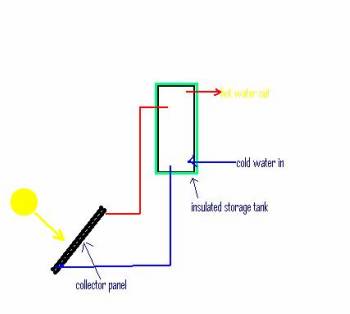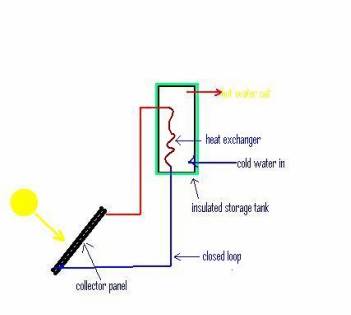|
Solar Hot Water
Solar hot water heating is the most common form of solar energy collection usage today. Even if you only want to use it to partially reduce your conventional hot water heater’s energy demands, it can be well worth while. Depending on your climate and hot water usage, today’s solar systems can provide 20-100% of your family’s hot water needs. On the following pages, I’m going to talk about the different types of solar hot water heaters, a little of their history, some considerations in designing and placing a system, the state of the art today and what the future might hold. Hot Water - The Luxury We Can Take For GrantedTo begin, let’s remember what a luxury running hot water is. Most of us are fortunate enough to be able to reliably expect to turn a knob on a tap and have hot water come out. This wasn’t always the case. There’s a great scene at the beginning of the movie A Lion In Winter. Richard Burton in his role as the king awakes in his bedchamber. He gets up, walks over to his wash basin where he then smashes his fist through the crust of ice that’s formed on the water overnight before he splashes it on his face. That’s how much hot water a king had. Even in the 19th century heating water was a major chore. Most heating in that era was done by burning wood or coal. Heating hot water required firing up the stove or furnace, heating the water in a container on top or filling a water jacket that was attached to one side of the stove or furnace. Then you had to wait for the water to heat and carry it to where you wanted to use it. Having a hot bath was a bit of a luxury in those times. Today, hot water is a luxury we can take for granted today. However the rising costs, both in terms of money and damage to our environment, of burning fossil fuels to heat our water makes the need for an alternative approach imperative. Heating hot water is the second largest energy usage in the typical household. Fortunately, solar hot water heating is practical right now and can go a long way to reducing fossil fuel usage. Let’s talk about the different type of systems and how they work. Different Types Of Solar Hot Water SystemsSolar water systems can be divided into several different categories. They can be passive or active, and direct or indirect. Passive solar systems depend on convection currents (the fact that hot water rises) to move water through the system. Active systems use pumps and controllers to move the water. These pumps require external energy sources. As we’ll see below, there are pros and cons to both approaches. In general, passive systems are simpler and active systems more flexible. The other way of categorizing solar heating systems is whether they’re direct or indirect. These categories are also referred to as open loop or closed loop. Direct v.s. Indirect Solar SystemsDirect (Open Looped)
In a direct system, the water that’s going to be used is heated directly by the sun. The diagram at right shows a passive convection, open loop solar hot water system. In the system, cold water enters the holding tank. Since it's denser than hot water, it flows naturally downwards the the solar collector. There, the sun heats it. As the water warms, it rises back to the tank, where it can be drawn off for household use. The water that flows through the collector is the water that's going to be used in the home and it's heated directly by the sun. It's called open loop because water is constantly flowing in an out of the system as it's used. Indirect (Closed Loop)
In an indirect system (also called a “closed loop” system), a fluid other than the water you’re going to use is heated by the sun. That fluid then passes through a heat exchanger where it heats water for use. The heat exchanger can be as simple as a coil of copper pipe passing through the middle of the insulated tank. The fluid from the solar collector circulates in a closed loop, driven by either active or passive means. In the tank, it heats the water that is then used in the house. An indirect system is one way to make it possible to use solar hot water heaters in frigid climates. The fluid that circulates through the solar collector can be a mixture and antifreeze (non-toxic polypropylene glycol) so it won’t freeze when the temperature drops and there’s no sun. Also, closed loop systems are useful in areas with very hard water. Hard water tends to form mineral deposits on the inside of the pipes in the solar collector which greatly reduces their effectiveness. In this situation, distilled water with or without antifreeze can be used to circulate through the solar collector to avoid this build up. On other pages of the site, I discuss active and passive systems and their variations in more detail. I describe different components of an effective solar hot water system as well factors that should be considered in selecting and planning a system. Click on the links below to go to pages with more information on any area you are interested in. LinksGNSCDCX17356269Click here to return to Alternative Energy Primer Home From Solar Hot Water Heating |
